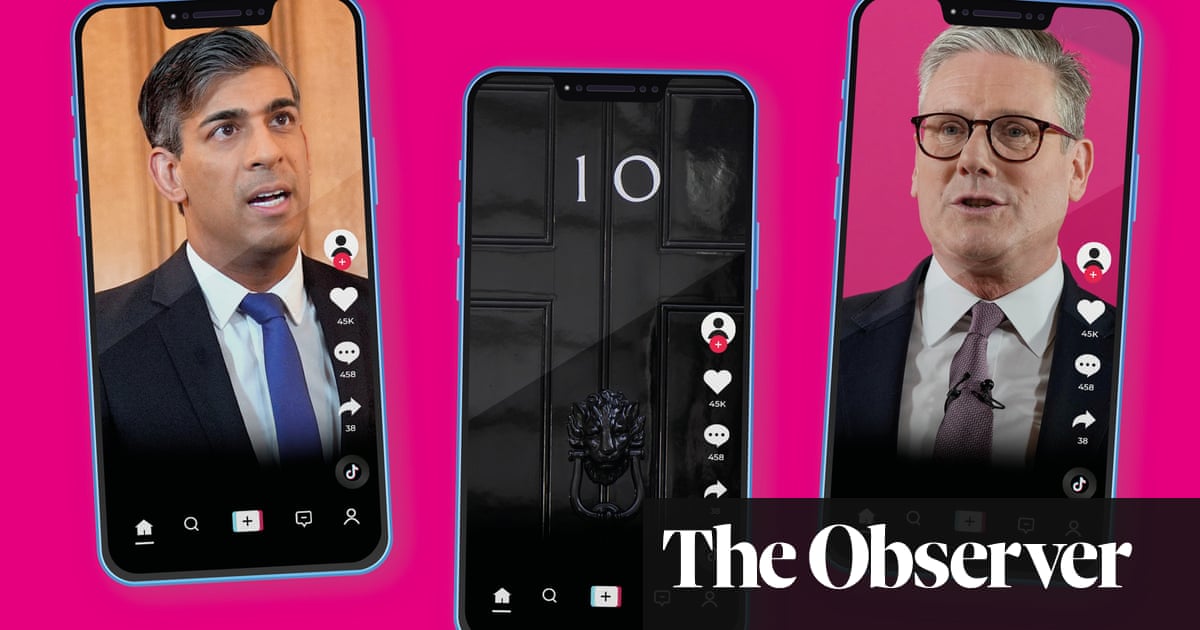Why would you hold an election in November? The question came from digital marketing guru Mike Harris and was asked in a message to his friend, Labourâs campaign manager, Morgan McSweeney, earlier this year. Digital advertising is more expensive in October and November because the internet is swamped with ads for Christmas and Black Friday, said Harris, the founder of communications agency 89up. Why not pick a cheaper time of year?
McSweeney shot back: âHow about June?â
Cheaper Facebook ads may or may not have been on Rishi Sunakâs mind when he blindsided his party by calling a surprise general election, but itâs certainly true that digital media is a vital part of the campaign for both Labour and the Conservatives.
The 2024 campaign has already been badged âthe first TikTok electionâ by some after both parties opened accounts on the social media platform a few days after Sunakâs rainswept Downing Street announcement. By Friday, Labour had posted 54 videos to the Toriesâ 14 â a mixture of meme battles, voter reactions and frontbenchers waving their hands earnestly while trying to explain policies in 30 seconds. Among the most watched was a video of Sunak struggling to dribble a football past some training cones with the caption: âYou get tackled by a cone but are trying to convince voters you can run the country.â
Behind the memes is a more complex story. Digital campaigning is important, but the parties have focused less on TikTok than on Facebook, YouTube and Instagram, as well as sending a stream of emails and text messages to supporters, updating their websites and marshalling their supporters in WhatsApp groups.
Labour spent more than £1.2m in the last week alone: about £605,000 on Google, mostly YouTube videos, and £684,964 on Metaâs Facebook and Instagram, according to Who Targets Me. They outspent the Conservatives by a factor of four â the Tories put £69,800 into Google and £280,406 on Meta, while the smaller parties spent almost nothing.
TikTok is free â it does not allow paid-for advertising by politicians or parties â but not easy: the social media teams need to work harder to persuade the appâs notoriously opaque algorithm to organically float their content on to usersâ phones, which becomes more likely as more people like, share, comment or re-post videos. For smaller, agile parties with low budgets, TikTok will feel like there is everything to win: views, engagement and people who finally find out who they are. Creators who know how itâs done believe Labour has had a better start.
âLabourâs TikTok is like a boxer throwing a combination of punches with a mixture of funny memes, well-produced key messaging and clips of successful media appearances,â said Phil Carr, who posts satirical videos âchronicling Britainâ for the 900,000 followers of his @philc84 account. He believes Labour has taken inspiration from Ryanair and other irreverent business accounts with its more popular videos making fun of the national service policy or using popular formats or sounds familiar to TikTokers.
The Conservatives have used more traditional politician-talking-to-camera videos from frontbenchers, and those are harder to judge, Carr said. âPeople like Sunak and Cameron will attract so many comments on a video that they will always do well in the algorithm. The issue is that the comments might not be positive.
âAt this late stage, I would have put lesser-known members who are possibly more relatable to a younger audience forward on to TikTok and let them run wild. It would have been a hell of a gamble but the polls suggest that taking big gambles is where they need to be.â
The main challenge on TikTok is keeping viewers engaged, he added. âWhether that makes them shocked, learn, laugh or just say âwowâ. You just pick your moments with a key message. I might make a three-minute TikTok and use one sentence in it to get my point across. The rest of that three minutes is, hopefully, entertainment. The parties need to be fun and pick their moments for the sledgehammer messaging.â
Many of the TikTok users who responded to the Observer to give their views on the election said they hadnât seen any videos from the political parties, and others were disappointed that Labour and the Liberal Democrats seemed to be relying on meme culture.
Some creators agree: Benjy Kusi, a London-based creator making content on diversity and inclusion as @benjy_lookbook said he felt Labour had misjudged the tone in some videos, such as its version of a meme of Cilla Black singing âSurprise Surpriseâ â the surprise in Labourâs version being Rishi Sunak âturning up on your 18th birthday to send you to warâ.
âAs someone who makes socio-political content on TikTok, I think that theyâve made an incorrect judgment on how to convey messages that resonate. Jumping on a viral trend to make a lighthearted joke about a serious topic may get you laughs, shares and views, but not much more.
âProviding clear and concise answers to popular questions like, for example, âHow will a Labour government benefit me as a young person?â, will drive more meaningful engagement than a meme from an audience that genuinely cares.â
Alice Bull, a TikTok strategy specialist, added that Labourâs meme content will be quick and easy to produce but that its feed is otherwise âa bit of a mess â visually inconsistent, and it appears to be lacking a solid content strategy.â This didnât stop her, however, from sharing the Cilla Black meme: âIt was a really interesting and smart way to meet those who are historically poor at turning out at elections where they are.â
So does TikTok matter all that much, or is it just a distraction â a way for the parties to have their videos picked up by TV shows such as Have I Got News For You? âThereâs a bunch of people saying âIs this a TikTok election?ââ said Sam Jeffers, founder of Who Targets Me, which aims to help voters understand political advertising. âAnd I think the answer is just a straight âNoâ. The main thing for the Tories is thereâs no voters there for them.â
Ofcom figures show that TikTok is used by 42% of adult internet users in the UK, well behind YouTube, WhatsApp and Facebook. But âvertical videoâ â TikTok, Instagram Reels and YouTubeâs Shorts â is much more important for 16- to 24-year-olds, with 83% on the platform compared with 2% of over-65s.
So it does make more sense for Labour to invest in TikTok to appeal to younger voters than the Conservatives, and Berry Cochrane, CEO of Forward Action, a digital mobilisation agency that works with NGOs, was surprised it had only just arrived on the platform.
âItâs been a massive focus of Joe Bidenâs strategy,â she said. âHeâs got a big influencer strategy, a huge part of how heâs thinking about messaging. It worked really well for him in the last US election. UK politicians, especially Labour, learn a lot from Democrats in the States. So I would have thought they would have been building up a presence on TikTok a long time ago.â
Security fears about Chinese influence over Bytedance, TikTokâs owner, are undoubtedly part of the reason why UK politicians have been reluctant to get involved, and the political context is also different â Biden is reacting to Donald Trumpâs social media clout â but US strategists such as Teddy Goff have suggested that building up an army of TikTokers who can share and amplify political messages is vital.
This is all a long way from the 2015 election campaign, when Labour spent more money on a single print advertisement in the Financial Times than it did on digital, said Mike Harris of 89up.
âThe Tories were absolutely nailing us on Facebook ads,â he added. Parties and the public woke up to the influence of social media on elections after the Observerâs revelations about Cambridge Analytica during the 2016 referendum, and all parties had some sort of social media strategy in 2017 and 2019.
But social media exists in an ever-shifting landscape, as algorithms are tweaked and public appetites shift. Twitter was central to Labourâs 2019 campaign, but Elon Muskâs renamed X barely registers this time around.
after newsletter promotion
Meta and Google have transparency registers that allow people to view political ads, see which groups were targeted and where the ads were shown.
Increasing numbers of people now watch YouTube on their TVs, often using voice control or simply trusting the algorithm to give them something interesting. And most smart TVs donât allow people to install ad blockers or skip the ads.
âWe see social media as something thatâs happening on your phone,â Harris said. âBut this election is happening on your phone and in your living room. Why is that interesting? Because political parties canât buy an advert on ITV but you can on YouTube. So the rules are significantly behind how parties are targeting voters.â
Another important change is that social media has become more expensive. âParties are reverting to a more blanket approach,â Harris said. âEssentially, the platforms donât really like political advertising, and theyâve worked out that the highly targeted ads are the ones that are most beneficial to their customer base, so theyâve made those more expensive.
âSo if you want to target people in England who are young, thatâs pretty cheap to deliver. But if you want people in Weybridge who are 30 to 60 and like this, that and the other â thatâs very expensive.â
That perhaps explains why Labour has spent so much more than the Conservatives.
It has taken a localised approach, and in the last week its most expensive purchase was a poster-style display ad only shown in Darlington, supporting its candidate Lola McEvoy, who needs a 3.8% swing to unseat Peter Gibson, one of the Conservativesâ âred wallâ MPs in 2019.
The Conservatives have opted for cheaper, less targeted advertising â its biggest spend was on two versions of a glossy attack video lampooning Keir Starmer as a doll in a box, ending with âWarning: Keir may change positions over timeâ.
For Harris, this reinforces the idea that the Conservatives are running a more defensive campaign, trying to hold on to seats rather than win them. The partyâs two flagship announcements so far, what politicos call âretail policiesâ, have been the âtriple lock plusâ pledge to raise pensionersâ personal allowances and national service, which appeal more to older voters. âI wonder if they did that because they want to spend their Facebook advertising on anyone over 65 in England, because it makes their campaign easier,â Harris said.
Another change in 2024 is that the parties can spend more â £34.1m across mainland Britain for parties contesting every seat. That covers all election expenses but still means there is plenty of scope for spending more before polling day on 4 July.
âYouâll see the parties home in on the places that they think they can win, or need to defend,â said Jeffers. But theyâll also be focusing more on the less flashy forms of communication â email, texts and websites.
âLabourâs first message after the election announcement came to me through SMS,â said Cochrane. âAnd it was a request for money, inevitably. But it was quick, it was direct. They sent three that day â the second was about volunteering and the third about donating, so my sense is that it worked well for them.â
At this phase of campaigning, the parties need to mobilise their volunteer base and persuade supporters to donate â around 80% of funding arrives in the later stages of the election. Ultimately, the digital election is about trying to get supporters to stop looking at their screens and engage in the real world.
âDigital advertising is a big message painted in primary colours for lots of people,â said Harris. âDoor-knocking is personal. The quality of engagement you get on a door knock is still the most likely way youâre going to persuade someone to go out and vote.â
Harris stood for his local council in 2010 and âknocked on every doorâ on polling day, which was the same day as a general election. They returned to the local party office in the evening to find that Labour HQ had sent them 2,000 DVDs of Ross Kemp urging people to vote Labour.
âI was up âtil 10 oâclock that night, posting Ross Kemp DVDs through letter boxes in tower blocks in Lewisham,â he said. âOn the day of the vote!â








